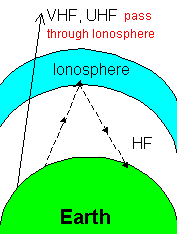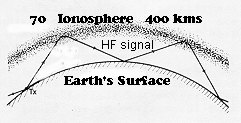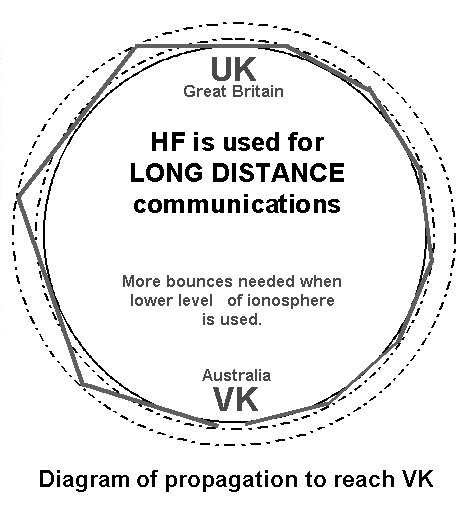



| |
Section 5
Propagation
5B1 Recall that the ionosphere comprises layers of ionised gases at heights between 70 and 400km above the earth.

The ionosphere is a layer of conductive gas at heights between 70 and 400 km. The ionosphere is part of the Earth's atmosphere that reflects HF radio waves back to Earth, giving the advantage of a greater range but it has no real effect on VHF or UHF radio waves that pass through and are thus lost into space.

Make sure you remember that the height of the ionosphere is from 70 to 400km - you may be asked this in the exam.
Understand that ionisation is caused mainly by ultraviolet rays from the sun.
To make the ionosphere reflective to radio waves at certain frequencies the gases which make up these layers are ionised by the effect of ultra violet waves
5B2 Recall that on HF most communication relies on the waves being refracted in the ionosphere.
When using HF almost all communication relies on the waves being returned to the earth, or refracted that is bent back, by the ionosphere.
Recall that HF can provide world-wide propagation depending on how well the ionosphere refracts the waves back to the earth.
The long distance communication is possible when using HF frequencies if the radio wave bounce back to earth off the ionosphere. Worldwide coverage requires several bounces between earth and the ionosphere for Worldwide and this propagation depends on how well the ionosphere bends / reflects the radio waves back to Earth

Recall that this varies with frequency, time of day, season and solar activity.
How well the
ionosphere bends the waves back to the earth varies with frequency, time
of day and season.
For worldwide propagation, the HF radio waves follow the curvature of
the Earth because the ionosphere prevents the HF radio Waves from
leaving the vicinity of the Earth.
Recall that a band is said to be ‘open’ when it supports skywave propagation.
The HF radio wave which are prevented from leaving the vicinity of the earth are called SKY WAVES and when the sky waves meet a well ionised ionosphere propagation conditions are said to be good for HF radio waves, of a particular band (of frequencies), to travel long distance, the band is said to be "open".
EXAM TIP
Make sure you remember that the height of the ionosphere is from 70 to 400km - you may be asked this in the exam.
It is apparent from wrong answers given to questions on this section that students do not understand what are the typical distance ranges that the various frequencies can achieve.
Please note that only HF achieve longest distances
Next is VHF
then UHF.
The origin of some of the text on this page is from the RSGB with additions by the web master